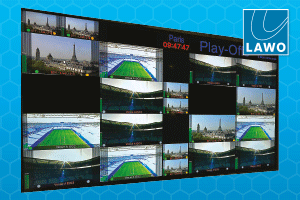The three-day event covered the areas of info-communications, broadcasting and emerging technologies.

The rains arrived, as they do in Singapore but that did not seem to dampen the spirits of the more than 1,800 exhibitors from 52 countries in attendance. ConnecTechAsia, the new technology event comprising CommunicAsia, BroadcastAsia, and the inaugural NXTAsia held at Marina Bay Sands and Suntec Singapore between 26-28 June 2018, had more than 900 product launches and 40 group pavilions. The three-day event covered the areas of info-communications, broadcasting and emerging technologies.
The new umbrella event is a reflection of the converging industries of telecoms, media and technology (TMT) and mirrors the fast-changing digital and business landscape in Asia, said Calvin Koh, Assistant Project Director for ConnecTechAsia in conversation with BroadcastPro ME on the sidelines of the event.
With the industry widely lauding the quality of conferences the organisers have traditionally put together each year, Koh stressed that for the 2018 edition, increased efforts were made to enhance the conference experience.
Our speaker profile was enhanced this year to make sure they address technology, media and telecommunications as a whole. The conferences are among the many platforms we created for the industry to share their knowhow and expertise and make the show experience more meaningful for both the exhibitors and visitors alike.
The conferences at BroadcastAsia addressed a slew of relevant issues ranging from 4K/UHD, OTT, monetisation on different platforms, live streaming, and AI in broadcasting, among other topical themes. Among the unique panel discussions was one dedicated to women in broadcasting negotiating the glass ceiling in the industry.
While bringing our shows under a single umbrella has helped us address the inter-connectedness brought about by the digital transformation, we make sure we are continually relevant and engage meaningfully with the industry, Koh added.

Among the conversations we had with exhibitors, Somu Patil, VP, APAC sales for Grass Valley highlighted the expanding opportunities in the region.
We see a lot of growth potential in the APAC region with a number of greenfield projects where deploying newer technologies is facilitated. We see major trends in 4K and HDR in countries such as China, Malaysia, Australia, among others, where there is focus on live production. We are seeing big trends in newsroom automation where broadcasters prefer to have more end-to-end integrated solutions. Since we are now a glass-to-glass service provider, we are in a good position to help customers achieve those objectives. The way the market is evolving, we see our customers as technology partners. We work from inception to the deployment of the projects.”

The ongoing FIFA World Cup was never far away in any discussion, and Eric Benetiere, VP Marketing & Sales for France-based forensic watermarking specialist, Content Armor underscored the increased demand for technologies to combat piracy.
We have solutions to deter piracy for premium video content either VOD or live sports. We insert our unique watermark IDs directly in the compressed domain. We dont need to decode the video and re-encode afterwards. This solution therefore costs less to deploy in an OTT distribution model.
Walking around the show floor, exhibitors had brought enough wow factor to remind us that ultimately the industry is about creating engaging content. Apart from flair bartending to dazzling sets at the Panasonic, Sony and Blackmagic stands, the 3D visuals floating in mid-air at the Kino-mo stand was a case in point.

Fresh from signing contracts with end-users in Vietnam, Vadzim Tsitou, Partner for Asia for Kino-mos Hypervsn solution explained how the hologram-like images are useful for the broadcast industry beyond the obvious appeal to the retail industry. He said: This device can be used everywhere and can be connected via the internet with a special cloud-based platform and you can broadcast from anywhere remotely.
Clearly viewer experience was centerstage at BroadcastAsia, where traditional newsrooms should have easy access to topics trending on social media and other sources. Kenziro Murakami, Founder and CEO of Japan-based Spectee Inc., explained how by using artificial intelligence, Spectee is able to reduce the time taken to analyse and sort social media news content, giving newsrooms faster access to the very latest user-generated videos.

Just as we were wrapping our heads around artificial intelligence detecting a fire in Mumbai or a crowd gathering in Poland, the folks at Prague-based Suitest reminded us of the importance of customer experience.
Mirko Nedeljkovic, Co-founder and CSO of Suitest explained how his solutions runs automated end-to-end test scenarios for OTT platforms on a Smart TV, Android TV, Apple TV, set-top box or Xbox One.
He said: For broadcasters, testing is important because there are many manufacturers of devices and applications that are based on the Hbb TV protocol, dont behave the same on each device. So it is important to test every application on every device in the market. Mere simulation is not good enough you need to have test results from real devices.

BroadcastAsia 2018 did a commendable job encapsulating the evolving broadcast and production industries with the emergence of technologies such as OTT platforms, live production, UHD content, and the latest cinematography and film production equipment, including 4K and 8K cameras from exhibitors such as Arri, Canon, Panasonic, RED and Sony. The event saw sessions from industry leaders such as Netflix, BBC, Mediacorp, Ooyala, ZengaTV and more, who discussed the role of social media and new technologies such as blockchain and how AI is redefining business models.
Also at the event was the first-ever live esports tournament the Southeast Asian League (SEAL) staged at the Esports Arena Studio within BroadcastAsia. Another new feature area was Radios New Wave, which highlighted the future of radio broadcasting and discusses shifts in audience behaviour impacted by streaming services such as Spotify and Amazon.
Clearly it is exciting, albeit overwhelming, at times, to be in the broadcast industry and organisers at BroadcastAsia managed to capture the complex world of convergence between technology, media and telecommunications.














































































